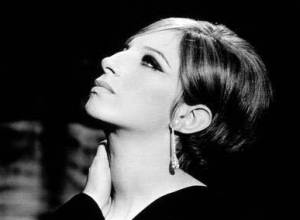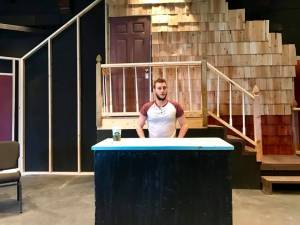The summer theatre season is set to begin this June with the Station Theatre’s production of Buyer & Cellar, a comedy by Jonathan Tolins. The play, a one-person show about a struggling actor who finds unconventional employment, takes place largely in the (real and documented) mall which resides in the basement of iconic entertainer Barbra Streisand. Directing the production is Thom Schnarre, whose previous directing credits at the Station include The Birds, How I Learned to Drive, and The Foreigner, among others.
I spoke with Schnarre about this unique show, about his cast of two, and about his directorial style.
•••••
 Smile Politely: How did you first discover the show? (Sub-question: Were you, prior to reading it, a fan of Ms. Streisand?)
Smile Politely: How did you first discover the show? (Sub-question: Were you, prior to reading it, a fan of Ms. Streisand?)
Thom Schnarre: I had two friends—Thom Miller, [the Station’s] Board of Directors Convener, and Michael Steen, a regular actor on the C-U stage—both tell me, “You have to do this script.”
I had read about the New York production and was interested in reading the script because the concept of a guy working in the mall in Barbra Streisand’s basement just seemed too bizarre not to be epic. Then I read it and found that it’s honestly the funniest script I’ve read in the last five years. It’s well-written, smart with good comic timing, moving, and quirky as hell, just like Streisand herself.
As for my feelings regarding the “Funny Lady,” full disclosure: I was in love with Streisand from the ages of five through thirty-five! I first saw her on The Ed Sullivan Show singing “My Coloring Book” and everything else in the room ceased to exist for a moment. No one else in the room noticed, but I did. Her singing, her mannerisms, the way she emoted through a song word by word, even her eye makeup and hair were like nothing I’d ever seen or heard before.
As I grew up, I watched every one of her movies, and my personal favorites were Nuts, A Star is Born, and On a Clear Day. I’ve seen them all at least a dozen times each. As I ended high school, I had the entertainment taste of a Jewish grandmother from Flatbush—all that was missing was my glasses on a gold chain around my neck. By the time I entered college, my love of Barbra was firmly ingrained. It made me super popular in the men’s dorms at EIU, but no matter what abuse was heaped upon me, I listened proudly to my favorite singer while most of my peers were jamming to Kansas and the Doobie Brothers.
 My idolatry of Barbra lasted until I began my coming out process. At that point, she became too camp and stereotypical to be cool and so I have to admit I deserted her. I’d still hum her songs in the shower when the mood struck, and I watched all of her movies when they came around, but she was kind of the dirty little secret of my new gay life.
My idolatry of Barbra lasted until I began my coming out process. At that point, she became too camp and stereotypical to be cool and so I have to admit I deserted her. I’d still hum her songs in the shower when the mood struck, and I watched all of her movies when they came around, but she was kind of the dirty little secret of my new gay life.
During the rehearsal process, both Coy and Kendall, my assistant director, asked me why Streisand has become so iconic to the gay community. I think it has to do with two things: the complete commitment she has made to the power of artifice and her ability to reinvent herself again and again despite her “unconventional looks.”
Artifice is her signature. It’s why she’s so popular with the drag community. Everything she does is an affected and studied performance. Every gesture is a statement to the balcony. Every outfit is a costume borrowed from wardrobe. Every song is punctuated with her signature off-kilter pronunciation or a gasp for breath for dramatic emphasis. You can love or hate her, but no one can ignore her. Her persona is the smoke and mirrors which allows a conventionally ordinary girl from Brooklyn to become a glamorous screen goddess. Every drag queen on the RuPaul circuit can relate, but I think it goes deeper than that. All of us who have imperfections—who are fat or skinny or too short or too tall or the wrong color or scarred or physically awkward can see someone just like us demanding respect and convincing the world that she is both beautiful and enviable. Now who can’t get behind that?
So, all of that said, directing this play, has helped me dust off my love for her and realize just how complex and amazingly unique Barbra Streisand truly is. The play’s take is one of a complex, flawed woman whose connection with others is always marred by her idiosyncratic perfectionism and her distrust of those who worship her talent and fame. I feel for her, and I still root for her to achieve the beauty, love, and perfection that she has always longed for in her every aspect of her life.

SP: Shifting to the production side of things… How does directing a one-person show change your approach? Are there particular challenges (or advantages) beyond “fewer people?”
Schnarre: I will admit that when I got the call that I was directing this piece, my first thought after accepting was, “Holy shit, how do I do this?”
The first challenge was finding the actor with the experience, charm, and stamina to do the role justice. I approached about a dozen actors about reading for the role and, after weeding out those who were concerned over various time constraints, scheduling conflicts, and the Herculean task of line memorization, I also put out a call for interested actors via the [Station] Facebook. Soon we had a night of limited auditions, just like many of our productions, and then I cast the role.
The rehearsal process is simplified because less people equal less schedule conflicts. The actor and my directorial staff are all that’s needed. That said, there needs to be an intimacy in the rehearsal process that can be a bit jarring. There is no reaction to a group’s performance, no hiding a personal criticism in a group assessment. If my actor has an issue, there’s no way to soften that. It’s a blunt and pointed dialogue at times, though the exchange is producing a very interesting product at present.
SP: Although it’s a one-person show, you do have two actors involved: Coy Wentworth and Evan Seggebruch. Can you talk a little about this? What do each of your actors bring to this show?

Schnarre: Coy Wentworth will perform the role of Alex More on all but one performance. He’s been a fixture at The Station since high school, has done university theatre, and has traveled to Chicago and L.A. for stage and screen work. His quirky energy and playfulness are solid building blocks for the Alex character. The character requires high energy, a flighty glee, and an emotional intelligence as he navigates through the more touching moments of the piece. Coy is up for that challenge and brings a lovely wit and life to Alex More.
I cast Evan Seggebruch in his first Station production, 33 Variations, when he was just nineteen. He had a lovely vulnerability and a youthful cockiness that the role demanded. Since then he’s really worked on his craft and developed a very engaging persona within the C-U theatre scene. I’ve been fortunate enough to work with him behind the scenes on Hand to God and American Idiot, and was also fortunate to have him join the cast of last summer’s The Foreigner. Both he and Coy have real acting chops, though they possess very different personas. As Alex, Coy has a West Hollywood jock-boy vibe, while Evan has the more WeHo puppy-twink persona, all wide-eyed and playfully energetic.
 Both work well with the high energy performance level needed for the role. Initially Evan’s schedule wouldn’t accommodate the rehearsal demands for the show, so he agreed to stage manage Buyer & Cellar instead. When my first choice for understudy developed conflicts with performing the role, Evan had attended enough rehearsals to know the blocking and be familiar with the lines. When the opportunity arose, he jumped at the challenge. We’ve given him another week to get his sea legs, as it were, but I think seeing both Coy throughout the run and then watching Evan’s take on the 20th will be a very interesting study on how an actor can make a role his own. They are both first-rate actors, and I am blessed to have them!
Both work well with the high energy performance level needed for the role. Initially Evan’s schedule wouldn’t accommodate the rehearsal demands for the show, so he agreed to stage manage Buyer & Cellar instead. When my first choice for understudy developed conflicts with performing the role, Evan had attended enough rehearsals to know the blocking and be familiar with the lines. When the opportunity arose, he jumped at the challenge. We’ve given him another week to get his sea legs, as it were, but I think seeing both Coy throughout the run and then watching Evan’s take on the 20th will be a very interesting study on how an actor can make a role his own. They are both first-rate actors, and I am blessed to have them!
SP: One of the bonus features of directing the first summer show for the Station is that your production is the “benefit show.” For those who don’t know about this, can you explain the benefit and how one gets involved?
Scnharre: The Station functions on the kind donations of our patrons and the revenue of our ticket sales. The latter can be rather uneven, though, so fundraising is a necessary element of staying alive in theatre in 2018. Some theatres in town rely on corporate donations, but The Station has always existed on personal donations alone. Up until this year, we have had two major funding drives: a winter mailing sent out before the holidays via snail mail, and the Summer Benefit.
 The benefit is a lovely garden party hosted at [Station founder and Artistic Director] Rick Orr’s picturesque home. Patrons attend a summer-fare dinner at Rick’s with some lovely entertainment and a chance to meet Station company members, then the entire event transfers to the Station for an evening performance and a delicious dessert accompanied with champagne! It’s quite lovely.
The benefit is a lovely garden party hosted at [Station founder and Artistic Director] Rick Orr’s picturesque home. Patrons attend a summer-fare dinner at Rick’s with some lovely entertainment and a chance to meet Station company members, then the entire event transfers to the Station for an evening performance and a delicious dessert accompanied with champagne! It’s quite lovely.
Buyer & Cellar is a perfect benefit show! It’s funny, moving, and lighthearted. You will leave the theater with a new appreciation for Ms. Streisand and a bounce in your step. What could be better on an early summer’s evening?
In addition to these methods of support, Kay Holley has established a very successful gofundme account over the past year or two to take care of specific needs of the theater. The new seating and the impending renovations of our audience rest rooms are just a few projects funded through this program.
SP: Before we go, I want to talk about style. You’ve acted and directed, but you also have a hand in a lot of design elements in this and other shows. Is there a particular way you would describe your theatrical style? Is there a common thread between Thom Schnarre shows?
Schnarre: I am always overly self-effacing with my response to this sort of question, so I decided to ask a cross-section of our company at our recent Work Day for a few terms they think of when they see I’m directing and/or designing a show. One of the best responses… said the experience is “immersive” and “a seductive form of storytelling that draws you in whether you want to be or not.” I do think both of these are trademark goals of my work and that these traits apply to our production of Buyer & Cellar.
Since this play is established from the start as a fantasy, our design elements are given the freedom to explore the space with humor and whimsy. You’ll see my take on Barbra’s Broadway “People” dress and several other iconic looks from the star’s past. It’s been a lot of fun to do, and I do think when the lights come up, people will be transported far from their everyday lives by the words and the performance. I always want the time spent in a show I’m involved with to be a lovely vacation from the audience’s hectic lives. Expect color, a sense of humor and a theatrical wonder when you come to one of my shows. And yes, with Buyer & Cellar, you can even expect some bubbles!
SP: Care to make a final pitch? Can you entice the audience in a single sentence?
Schnarre: If you want an engaging and rollicking evening’s entertainment with a sweet heart to it, Buyer & Cellar is the performance of the summer that you cannot miss!
*****
Buyer & Cellar begins its residence in the Station Theatre on June 7th and runs through June 23rd. Tickets for Station productions are $15 regular admission, $10 for students and seniors. All performances this summer will begin at 7:30 p.m.
As mentioned above, the June 16th performance is reserved for those attending the Station’s annual Summer Benefit. For more information on this event, you may send a message to the Station’s website or Facebook page.
Thom Schnarre provided his photo. Evan Seggebruch photo by Scott Wells. All other photos courtesy of Celebration Company at the Station Theatre Facebook page.








